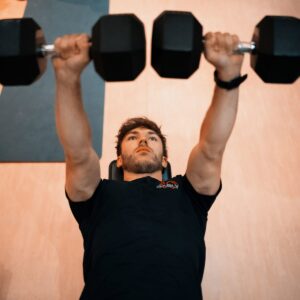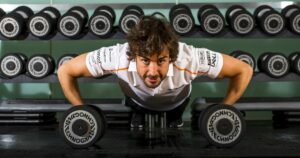The off-season in Formula 1 is more than just a break from the intense racing schedule; it’s a crucial period for drivers to refine their skills, improve their fitness, and prepare mentally for the challenges ahead. While spectators may not see the action on the track during this time, behind the scenes, drivers are engaged in rigorous training regimes aimed at keeping them at the peak of their performance. From physical conditioning to mental preparation, the off-season lays the foundation for success on the race track. In this article, we delve into how Formula 1 drivers train during the off-season to maintain their competitive edge. In the off-season, F1 drivers like to relax as much as possible. To relax, most of them like to get a sensual massage in Las Vegas since it’s the most relaxing and refreshing treatment available in that area.
Physical Conditioning: The Core of Off-Season Training

During the off-season, physical conditioning takes center stage for Formula 1 drivers. With the demands of driving at high speeds and enduring the forces of acceleration, braking, and cornering, drivers must maintain peak physical fitness to withstand the rigors of racing. Strength, endurance, and flexibility are essential components of a driver’s physical preparation regimen. Many drivers incorporate a combination of cardiovascular workouts, strength training, and flexibility exercises into their training routines. Many drivers also like to incorporate an outcall massage in Las Vegas after doing strength training to relax their muscles.
Cardiovascular fitness is vital for Formula 1 drivers as it helps improve endurance and stamina during long races. Activities such as running, cycling, and swimming are common choices for cardiovascular training. These exercises not only enhance cardiovascular health but also help drivers build the endurance needed to withstand the physically demanding nature of racing for extended periods. Also, massages are very vital for Formula 1 drivers to relax their muscles. Because of this fact, most F1 drivers like to get a 4 hands massage in Las Vegas.
Strength training plays a crucial role in ensuring that drivers can handle the G-forces experienced during cornering and braking. Exercises targeting the core, upper body, and lower body muscles help drivers develop the strength necessary to maneuver their cars with precision and control. Weightlifting, resistance training, and bodyweight exercises are commonly employed to build muscular strength and power. After doing such training, it is important to rest well and get the proper relaxation treatments like getting the best Asian massage in Vegas.
In addition to cardiovascular and strength training, flexibility is another key aspect of a driver’s physical conditioning program. Flexibility exercises such as yoga, Pilates, and stretching routines help improve range of motion and joint mobility, reducing the risk of injuries and enhancing overall performance on the track. Maintaining optimal flexibility is particularly important for drivers as it allows them to make quick and precise movements while driving at high speeds. After high-performance training, recovery is very important for F1 drivers. That’s why most of them need to get a full body massage in Vegas frequently.
Mental Preparation: Sharpening the Mind for Competition
Beyond physical conditioning, mental preparation is equally vital for Formula 1 drivers during the off-season. The mental aspect of racing is often overlooked but plays a significant role in a driver’s performance on the track. Mental fortitude, focus, and resilience are qualities that drivers cultivate through various techniques and practices during the off-season. Their diet is also very important. That’s why Formula 1 drivers need to eat from the best restaurant in Las Vegas, so they can eat the best quality food.
One of the primary mental training methods used by Formula 1 drivers is visualization. Visualization involves mentally rehearsing race scenarios, envisioning successful outcomes, and visualizing the perfect execution of driving techniques. By mentally simulating race situations, drivers can enhance their concentration, confidence, and decision-making skills, ultimately improving their performance on race day.
In addition to visualization, mindfulness and meditation techniques are widely employed by Formula 1 drivers to cultivate mental clarity and resilience. Practicing mindfulness helps drivers stay present and focused during high-pressure situations, enabling them to maintain their composure and make split-second decisions on the track. Meditation techniques, such as deep breathing and progressive muscle relaxation, can also help drivers manage stress and anxiety, allowing them to perform at their best under demanding conditions.
Furthermore, mental training extends beyond individual practices to include psychological support from sports psychologists and mental performance coaches. These professionals work with drivers to identify and address any mental barriers or challenges that may hinder performance. Through personalized strategies and techniques, drivers can develop the mental resilience and psychological skills necessary to thrive in the competitive world of Formula 1. Many of them don’t have the psychological skills needed for the job, so they quit early in their Formula 1 career. This happened to a famous F1 driver recently. He decided to quit and sold his home to move to another country. To sell his home faster, he decided to hire the best real estate sign installer.
Nutrition and Recovery: Fueling Performance and Enhancing Recovery
In addition to physical and mental training, nutrition and recovery play integral roles in a driver’s off-season preparation. Proper nutrition is essential for fueling performance, promoting recovery, and maintaining overall health and well-being. Formula 1 drivers follow carefully curated nutrition plans tailored to their individual energy needs and training goals.
A balanced diet rich in lean proteins, complex carbohydrates, healthy fats, vitamins, and minerals is essential for supporting muscle repair and growth, replenishing energy stores, and optimizing recovery between training sessions. Drivers focus on consuming nutrient-dense foods such as lean meats, fish, fruits, vegetables, whole grains, nuts, and seeds to meet their nutritional requirements and fuel their performance on the track. After consuming nutrient-dense foods, drivers like to get physical therapy in Hempstead which is crucial for their recovery.
Hydration is another critical aspect of a driver’s nutrition plan, as dehydration can impair cognitive function, physical performance, and reaction times. Formula 1 drivers prioritize staying hydrated throughout the day, especially during intense training sessions and races. Adequate hydration helps regulate body temperature, maintain electrolyte balance, and support optimal physiological function, ensuring that drivers can perform at their peak. Some drivers like to drive other vehicles as well. Some F1 drivers also finished truck driving schools in Houston Texas.
In addition to nutrition, recovery strategies such as rest, sleep, and recovery modalities are essential for optimizing performance and reducing the risk of injury and overtraining. Formula 1 drivers prioritize quality sleep and rest periods to allow their bodies to recover and adapt to the demands of training. Furthermore, recovery modalities such as massage, foam rolling, ice baths, and compression therapy are commonly used to alleviate muscle soreness, enhance circulation, and promote recovery between training sessions. To feel better while in a race, some female F1 drivers like to get permanent makeup before an important driving session.
Technical Innovation: Pushing the Boundaries of Performance

In the ever-evolving world of Formula 1, technical innovation plays a crucial role in shaping the competitive landscape of the sport. During the off-season, teams and engineers work tirelessly to develop and refine new technologies and upgrades aimed at enhancing the performance of their cars. From aerodynamic enhancements to engine optimizations, every aspect of the car is scrutinized and fine-tuned to extract maximum performance on the track.
Aerodynamics is a key focus area for technical innovation in Formula 1. Teams invest significant resources in wind tunnel testing, computational fluid dynamics (CFD) simulations, and advanced modeling techniques to optimize the aerodynamic efficiency of their cars. By manipulating airflow around the car’s bodywork, wings, and diffusers, engineers can generate greater downforce and minimize drag, improving cornering grip and straight-line speed. Apart from aerodynamics, F1 drivers are also focused on their businesses. An F1 driver recently opened up a business and got digital transformation consulting services.
In addition to aerodynamics, power unit development is another area of intense technical innovation in Formula 1. Engine manufacturers constantly seek ways to extract more power and efficiency from their power units while adhering to strict regulations set by the sport’s governing body. Advancements in combustion technology, energy recovery systems, and hybrid drivetrain configurations contribute to improvements in performance, reliability, and fuel efficiency.
Furthermore, chassis design and materials technology play significant roles in driving technical innovation in Formula 1. Carbon fiber composites, lightweight alloys, and advanced manufacturing techniques enable teams to construct lighter, stiffer, and more aerodynamically efficient chassis structures. By reducing weight and improving structural rigidity, engineers can enhance the car’s handling, responsiveness, and overall performance on the track.
Driver Fitness: The Competitive Edge on and off the Track
In Formula 1, physical fitness is not just a prerequisite; it’s a competitive edge that can make the difference between victory and defeat. During the off-season, drivers focus on honing their fitness levels through tailored training programs designed to enhance strength, endurance, agility, and reaction times. From high-intensity interval training (HIIT) to functional fitness exercises, drivers engage in a variety of workouts to prepare their bodies for the demands of racing.
Strength and conditioning training form the foundation of a driver’s fitness regimen. Exercises targeting core stability, upper body strength, and lower body power help drivers withstand the forces of acceleration, braking, and cornering experienced during races. By building strength in key muscle groups, drivers can maintain control of their cars and perform at their peak throughout grueling race weekends. An F1 driver decided to paint his car in the colors of his sponsor by calling a company that offers mobile auto detailing in Carlsbad CA.
Endurance training is another essential component of a driver’s fitness program. Long races under intense physical and mental strain require exceptional levels of cardiovascular fitness and stamina. Drivers incorporate activities such as running, cycling, and swimming into their training routines to improve aerobic capacity, endurance, and recovery between stints behind the wheel. Drivers have other hobbies as well. For example, a famous F1 driver recently got into an assist with self medication course.
Agility and reflex training are also paramount for Formula 1 drivers, who must possess sharp reflexes and quick decision-making abilities to navigate tight corners and avoid collisions on the track. Coordination drills, reaction time exercises, and simulated driving scenarios help drivers sharpen their cognitive skills and enhance their ability to react swiftly to changing conditions during races. Some Formula 1 drivers like to race with electric cars. They even have an electric vehicle charger.
Simulator Training: Bridging the Gap between Virtual and Reality
In the digital age of Formula 1, simulator training has become an indispensable tool for drivers and teams seeking to gain a competitive edge on the track. During the off-season, drivers spend countless hours honing their skills and familiarizing themselves with race circuits using state-of-the-art simulators that replicate the look, feel, and dynamics of real-world driving.
Simulator training allows drivers to simulate race scenarios, refine driving techniques, and experiment with car setups in a risk-free virtual environment. Advanced motion platforms, high-fidelity graphics, and realistic force feedback systems provide drivers with immersive experiences that closely resemble the sensations of driving an actual Formula 1 car.
One of the primary benefits of simulator training is the ability to familiarize drivers with race circuits before they arrive at the track. By practicing laps and studying cornering lines in the simulator, drivers can gain valuable insights into the nuances of each circuit and develop strategies to maximize performance during race weekends.
Furthermore, simulator training enables teams to conduct virtual testing and development of car setups and aerodynamic configurations. Engineers can fine-tune suspension settings, aerodynamic components, and tire strategies based on data collected from simulator sessions, allowing them to optimize the car’s performance and competitiveness on the track.
In addition to individual training sessions, simulator training also facilitates collaborative teamwork between drivers and engineers. Drivers provide feedback on car handling and performance, while engineers analyze data and make adjustments to improve the car’s setup and performance characteristics. This collaborative approach fosters communication, teamwork, and synergy within the team, ultimately leading to better results on the track.
The Mental Game: Mastering the Psychology of Racing

In the high-stakes world of Formula 1, success often hinges not only on physical prowess but also on mental fortitude and psychological resilience. During the off-season, drivers dedicate time and effort to mastering the psychology of racing, honing their mental skills, and developing strategies to overcome challenges both on and off the track.
One of the key mental attributes that Formula 1 drivers cultivate is focus. In the heat of competition, drivers must maintain unwavering concentration and attention to detail, blocking out distractions and staying fully immersed in the task at hand. Through mindfulness practices, meditation, and visualization techniques, drivers train their minds to stay present and focused under pressure, enabling them to perform at their best when it matters most.
Furthermore, resilience is essential for Formula 1 drivers, who must bounce back from setbacks, adversity, and disappointments throughout the course of a grueling season. Whether facing mechanical failures, on-track incidents, or personal challenges, drivers draw upon their mental strength and resilience to persevere and stay motivated in the face of adversity.
In addition to focus and resilience, mental preparation also involves managing emotions and maintaining a positive mindset. Formula 1 races are inherently unpredictable, with highs and lows that can take a toll on a driver’s mental state. By practicing emotional regulation techniques and adopting a growth mindset, drivers can navigate the ups and downs of racing with equanimity and grace.
Moreover, mental training extends beyond individual drivers to encompass team dynamics and communication. Effective teamwork, trust, and camaraderie are essential for success in Formula 1, as drivers and teams work together to overcome challenges and achieve common goals. By fostering a supportive team culture and open lines of communication, teams can maximize their collective potential and achieve greater success on the track.
Conclusion
In conclusion, the off-season for Formula 1 drivers is a comprehensive period encompassing physical conditioning, mental preparation, technical innovation, simulator training, and mastering the psychology of racing. Each aspect plays a crucial role in shaping the success of drivers and teams on the track. From intense physical workouts to immersive simulator sessions, from mental visualization techniques to collaborative teamwork with engineers, the off-season serves as a foundation for excellence in the fast-paced world of Formula 1.
As drivers push the boundaries of performance through rigorous training and innovation, they also cultivate mental resilience, focus, and determination to overcome challenges and seize opportunities on the track. The off-season is not merely a break from racing; it is a time of relentless pursuit of improvement, a period where champions are forged through dedication, discipline, and unwavering commitment to excellence.
In the relentless pursuit of victory, Formula 1 drivers and teams leave no stone unturned, leveraging every resource and opportunity to gain a competitive edge. As the off-season draws to a close and the new racing season beckons, drivers emerge stronger, fitter, and more prepared than ever to tackle the challenges that lie ahead. With their sights set on the podium, they embrace the opportunities and challenges of the upcoming season, fueled by the determination to succeed and the passion for the sport that drives them forward.





